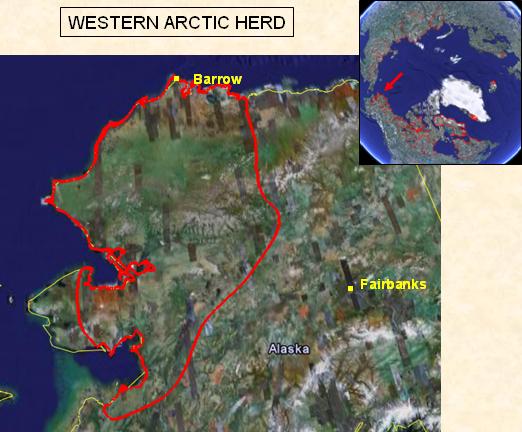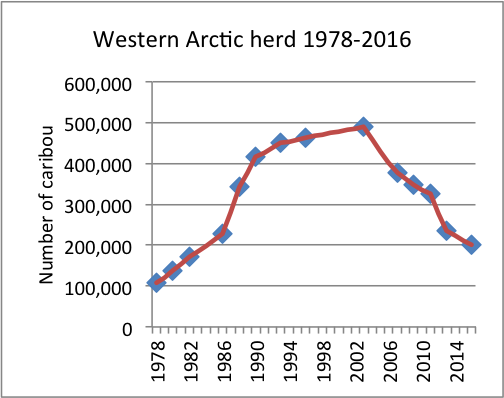
DOWNLOAD Western Arctic Herd animation (2.86Mb) - Shows satellite collar movements on 87 adult females between 1988 and 2006. Animation should open automatically in QuickTime Player.
Status and Trends: In July 2016, the herd was 201,000 caribou (ADF&G 2017) which is a 59% decline since the peak size of 490,000 in 2003. The rate of decline 2010 to 2016 was an exponential rate of -0.069 which is a halving rate of 10 years.

Ecology: The calving and summer ranges are tussock tundra uplands extending toward the western coast. The winter ranges are also mostly tussock tundra with lichens and shrubs. About 30% of the winter range is within the boreal forest. The cows have high fidelity since at least the 1960s to the calving grounds in the Utuktok Hills. The largely clockwise movements on the summer ranges take the cows south through the Brooks Range foothills and then northwest to the coastal ranges. In the fall migrate south to the Seward Peninsula for winter. On some areas of the winter range, lichen cover has declined while shrub and grass cover have increased (Joly et al. 2007). Despite the decline in herd size, the size of the annual range between 2000 and 2014 has not changed.
Since 1996, more caribou have wintered on the Seward Peninsula which is a problem for the domestic reindeer herders as the reindeer follow when the caribou leave the winter ranges. The reindeer may have been the source of Brucella suis biovar 4 in the caribou. Since the mid-1980s, the reindeer have been vaccinated against Brucella which may have contributed to the declining prevalence in the WAH caribou from 23 to 3 % in seroprevalence 1980 to 2010 (Beckmen et al. 2013).
Sightings of wolves and bears have increased since 2012 based on reports from communities. People from about 40 subsistence-based communities annually harvest an estimated 10,000–15,000 caribou while non-resident hunters take about 500–800 caribou.
The ranges are largely intact with only one large mine, the Red Dog lead and zinc mine on the herd’s summer and fall ranges. The mine is linked by a 84 km all-weather gravel road to a port and since 1990, haul trucks carrying ore complete about 70 trips per day. Initially, the road was private but the people from Kivalina are now allowed to use four-wheelers to hunt from the road. During fall migration, the haul road may have influenced caribou movements as some collared caribou delay their approach to and crossing of the road. More road corridors are possible as the National Petroleum Reserve-Alaska (NPR-A) overlaps calving and summer ranges and more mines are being planned.
Climate: The Western Arctic herd has a maritime arctic climate with cooler summers and warmer winters and high precipitation. Both the drought index and the oestrid index are low but winter ranges have a relatively high number of days with freezing rain and rain-on-snow days (CARMA unpubl. data). The only significant trend (1989-2016) is an increasing October temperature. An extreme event was a midwinter thaw with rain occurred during December 2005 and, by spring 2006, many caribou were in poor body condition and adult female mortality was 32%. A similar level of mortality occurred in the 2011-2012 winter which had deep snow and high levels wolf kills (Dau 2011, Dau 2015).
Monitoring: Adult mortality, calf production and recruitment, sex and age movement patterns, and distribution are annually monitored. Since the mid-1980s, the trend in adult survival and productivity has decreased especially since 2003. The 3-year moving average for recruitment has been less than 20% since 1999 and by 2010 was 13%. June calf:cow ratios during 1982–2015 did not show a trend but fall calf:cow ratio declined during 1982–2015. Mortality increased from 13.5+1.5SE (1987-1990) to averaged 18.8+1.3 SE (1990-2010) and was exceptionally high in 205-06 and 2011-12 winters (Dau 2011, Dau 2015). However, in 2015 and 2016, rates improved as overwinter survival for the calves was 82 % and calf production was high at 54 calves :100 cows in October with high 90% adult survival.
Management: Causes of decline include fall and winter icing events together with possibly increasing wolf and grizzly bear predation. From 1999 to 2010, hunters annually took an average 2.8% of the herd which from 2011 to 2013 increased to 4.6% and 6% by 2016. While hunting is unlikely to have precipitated the decline, the current level (2013) of about 12,000 caribou could accelerate or prolong the decline.
The Alaska Department of Fish and Game manages the herd together with the US National Park Service, US Bureau of Land Management and US Fish & Wildlife Service. Alaska has a dual management system between state and federal government as the Alaska National Interest Lands Conservation Act requires a rural preference for subsistence users over other uses on federal lands. ADF&G’s Intensive Management Objective for the herd is 200,000 and the needed harvest level is 12,000-20,000.
The WAH Working Group (WG) is the advisory cooperative-management group stated in 1997 to represent communities, government agencies, sport hunters and guides, conservationists, and reindeer herders. The Working Group collaborative 2011 plan recommends management levels with increasingly restrictive regulations depending on the herd’s size and trend. In 2011, the herd’s status changed from liberal to conservative and by 2016, herd was at the threshold between conservative and preservative. Conservative management is no harvest of calves, no non-resident cow harvest, encourage voluntary reduced resident cow harvest and limit bull subsistence harvest if < 40 bulls:100 cows. Management actions in 2016 included federal closure of Unit 23 which reduced visiting hunters by 50% (ADF&G 2017).
For further information:
Alaska Board of Game: http://www.adfg.alaska.gov/index.cfm?adfg=gameboard.main
Bureau of Land Management:
http://www.blm.gov/ak/st/en/prog/planning/npra_general/ne_npra.html
The Western Arctic Caribou Herd Working Group https://westernarcticcaribou.net/the-group/
http://www.wildlife.alaska.gov/index.cfm?adfg=pubs.trails
Federal Subsistence Management Program https://www.doi.gov/subsistence
Literature Cited:
ADFG. 2017a. Alaska Department of Fish and Game Staff Comments Tab 1.3 Region V Caribou for the Alaska Board of Game Meeting Fairbanks, Alaska February 17-25, 2017. Alaska Department of Fish and Game Division for Alaskan Board of Game, Kotzebue, AK, January 2017
ADFG. 2017b. Alaska Department of Fish and Game Staff Comments Interior/Northeast Arctic Region Proposals Alaska Board of Game Meeting Fairbanks, Alaska February 17-25, 2017. Alaska Department of Fish and Game Division for Alaskan Board of Game, Kotzebue, AK
Beckmen, K., I. H. Nymo , M. Tryland, K. Åsbakk, A. K. Larsen, J. Godfroid, J. Dau and R. Rødven. 2013. Spatio-temporal trends in prevalence of anti-Brucella antibodies in barren-ground caribou (Rangifer tarandus granti) in Alaska – an example of enzootic equilibrium. The 66 th Annual Brucellosis Research Conference, Chicago, IL, USA. December 2013.
Dau, J. 2011. Western Arctic Herd caribou management report. Pages 187-250 in P. Harper, editor. Caribou management report of survey and inventory activities 1 July 2008-30 June 2010. Alaska Department of Fish and Game. Federal Aid in Wildlife Restoration Grants W-33-3 and W-33-4. Juneau, Alaska. 345 pp.
Dau, J. 2015. Units 21D, 22A, 22B, 22C, 22D, 22E, 23, 24 and 26A. Chapter 14, pages 14-1 through 14-89 In] P. Harper, and Laura A. McCarthy, editors. Caribou management report of survey and inventory activities 1 July 2012–30 June 2014. Alaska Department of Fish and Game, Species Management Report ADF&G/DWC/SMR-2015-4, Juneau.
Joly, K., R.R. Jandt, C.R. Meyers and M.J. Cole. 2007. Changes in vegetative cover on Western Arctic Herd winter range from 1981 to 2005: potential effects of grazing and climate change. Rangifer Special Issue No. 17:199-207.
Western Arctic Caribou Herd Working Group. 2011. Western Arctic Caribou Herd Cooperative Management Plan - Revised December 2011. Nome, Alaska. 47 pp.
Wilson , R. R., L. S. Parrett, K. Joly, J. R. Dau. 2016. Effects of roads on individual caribou movements during migration. Biological Conservation 195: 2–8.
